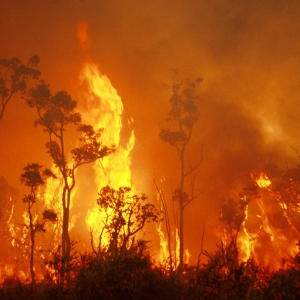Federal Water Tap, December 30: Streamflow Changes Associated with Ecosystem Decline, USGS Finds
The Rundown
The U.S. Geological Survey publishes the first national assessment of man-made changes to river flows. A Pennsylvania senator tries again to require mandatory disclosure of fracking chemicals. The EPA proposes not requiring petroleum and coal manufacturers to demonstrate the financial capacity to clean up hazardous wastes. The Army Corps intends to review flood risks from reservoirs it operates on a Houston waterway. A binational commission gathers input on proposed nutrient limits for the Red River. And lastly, the clock ticks for the EPA to announce its intention to regulate PFAS chemicals in drinking water.
“Land- and water-management practices have modified natural streamflows across the Nation. Low flows are more frequent, are of shorter duration, and vary less from one year to the next than they would naturally. High flows have been reduced, are less frequent, are of shorter duration, and vary less from one year to the next than they would naturally. In addition, daily flow fluctuations are higher than natural across the Nation.” — Findings from the U.S. Geological Survey’s first national assessment of man-made changes to U.S. rivers.
By the Numbers
20: Chemicals that the EPA has marked as a high priority for risk evaluation. The agency’s action was mandated by a 2016 act of Congress. (U.S. Environmental Protection Agency)
1.2 million: Miles of the nation’s rivers where flows have been altered by man-made changes such as urbanization, dams, and groundwater pumping. That number represents about one-third of the nation’s river-miles. (U.S. Geological Survey)
News Briefs
Fracking Bill
Sen. Bob Casey (D-PA) re-introduced the FRAC Act, a bill that would require oil and gas companies to disclose the type and volume of chemicals they inject underground during hydraulic fracturing operations.Casey has introduced a version of this bill every session of Congress for the last decade.
EPA Rejects Cleanup Insurance Rules for Petroleum and Coal Manufacturers
The EPA proposes that petroleum refineries and industries that turn coal into other marketable products will not have to show they have the money to clean up hazardous spills.Requiring companies to show they have the money to clean up hazardous materials — through bonds, insurance, or credit — is designed to eliminate the need for taxpayer-funded remediation.
The EPA argues that existing state and federal requirements are sufficient for the petroleum and coal manufacturing industry.
The proposed rule follows a pattern: in recent years the agency has rejected financial responsibility obligations for the hardrock mining and electric power industries.
The hardrock mining rules were challenged by environmental groups, but in July the D.C. Circuit Court upheld the agency’s decision. The EPA cites that ruling in its current proposal for petroleum and coal.
Public comments on the proposed rule for the petroleum and coal manufacturing industry are being accepted through February 21, 2020. Submit them via www.regulations.gov using docket number EPA-HQ-OLEM-2019-0087.
Studies and Reports
River Disruption
Over the last three decades, changes in land and water management have disturbed river flows more than climatic changes, according to the U.S. Geological Survey’s first national assessment of man-made alterations to river flows.Flow disruptions have ecological consequences. The study found fewer fish and invertebrates in the streams in which water levels had been most dramatically altered.
“In every region assessed by the USGS, streamflow modification was associated with reduced ecological health,” as measured by fish and invertebrates, the report states.
Those modifications come in many forms. Dams store water and shift the timing of flows. Urbanization creates more hard surfaces, which result in higher peaks in streamflow after a storm. Groundwater pumping robs streams of water that flows underground.
The study looked at data from more than 3,300 stream gauges.
On the Radar
Nutrient Targets for Red River
The binational commission that investigates water issues that affect Canada and the United States will hold a public meeting on January 16 in Fargo, North Dakota, to discuss water quality recommendations for the Red River.The Red River forms part of the border between Minnesota and North Dakota, and then crosses into the province of Manitoba. A board convened by the International Joint Commission recommended limits on nutrient concentrations in the river. Those nutrients are phosphorus and nitrogen, which cause harmful algal blooms downstream in Lake Winnipeg.
Houston Flood Risk Study
The U.S. Army Corps of Engineers will assess flood risks on a waterway that flows through central Houston.The study centers on Buffalo Bayou and two reservoirs on the waterway that are operated by the Corps: Addicks and Barker. The watershed was inundated during Hurricane Harvey, and both reservoirs set new water-level records.
Options that the Corps will assess include bypass tunnels, property buyouts, building new reservoirs, and dredging existing reservoirs to increase capacity.
The study will also evaluate Addicks and Barker dams for safety improvements.
Public comments on the scope of the study will be accepted through January 26, 2020. Send them to BBTRS@usace.army.mil. A draft environmental impact statement is expected in the summer of 2020.
PFAS Regulatory Determination
EPA Administrator Andrew Wheeler has said that the agency will announce by the end of the year whether it intends to regulate two prominent PFAS chemicals in drinking water.Federal Water Tap is a weekly digest spotting trends in U.S. government water policy. To get more water news, follow Circle of Blue on Twitter and sign up for our newsletter.
Brett writes about agriculture, energy, infrastructure, and the politics and economics of water in the United States. He also writes the Federal Water Tap, Circle of Blue’s weekly digest of U.S. government water news. He is the winner of two Society of Environmental Journalists reporting awards, one of the top honors in American environmental journalism: first place for explanatory reporting for a series on septic system pollution in the United States(2016) and third place for beat reporting in a small market (2014). He received the Sierra Club’s Distinguished Service Award in 2018. Brett lives in Seattle, where he hikes the mountains and bakes pies. Contact Brett Walton





Leave a Reply
Want to join the discussion?Feel free to contribute!